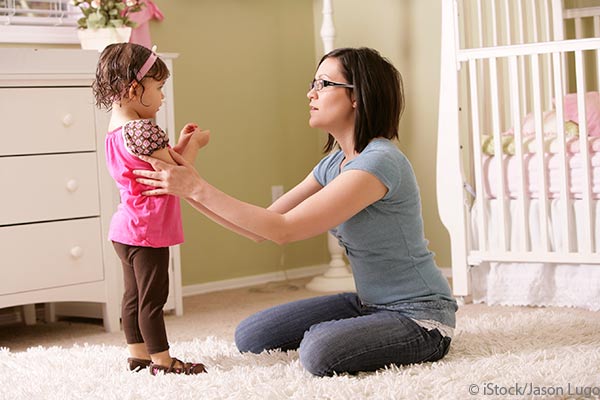There are many, many parenting books out there that espouse a myriad of strategies for getting children to do what we want them to do. I have read a lot of them. Many of them say very similar things but with a slightly different twist. I find the “Positive Discipline” books by Jane Nelsen to be the most universally applicable and easy to read for parents with all ages and types of children.
Through my 30+ years of parenting, reading and working with young children and parents, I have developed this list of strategies that are a mixture of mostly positive discipline and a few other approaches. I have tried to simplify them in a way that is easy to remember and easy to use for parents. They are in ascending order; meaning that the first few are the ones to use most often and the later ones are most useful in more serious situations. Remember that there is no magic bullet that works with all children in all situations. The key is to have a “tool box” full of tools that you can pull out and try; and if they don’t work, you can put them back in the box for use another day.
It is also important to know that your child’s behavior is caused by three things:
- Where your child is developmentally.
- Who your child is temperamentally.
- What is going on environmentally for your child and your family.
When your child is acting out in some way, try to figure out what is causing the behavior. What about this behavior has to do with how old your child is and what skills he or she has or doesn’t have? What about this behavior has to do with your child’s temperament and how he or she interacts with the world? What about this behavior has to do with things like being tired, hungry, or stress in the family? When you can answer these questions, you will have a much easier time knowing which tool to pull out of your parenting toolbox.
So, here you go:
-
Distraction
Distraction works best with very young children, but is always a great place to start. Often turning a request into a game, singing a song, or using humor is all it takes to get a child out of a negative frame of mind and encourage her to cooperate. For example: “Let’s see if you can pick up those blocks by the time I count to 10! Ready set GO!”
-
Redirection
In my opinion, redirection is the most universally useful tool in your Parenting Toolbox! It means to simply tell your child what you want him to do rather than what you don’t want him to do. It requires a simple, but sometimes difficult, change to the way you talk. Avoid “don’ts”. Be encouraging instead of punishing. For example: Instead of “Don’t run!,” try “Please use your walking feet inside.” Or, instead of “Don’t throw your food,” try “Please keep your food on the table.” And, if you look for what your child is needing to do, you might say “It looks like you need to run — let’s go outside.” Or, “It looks like you are all done eating — let’s clear the table and go play”.
-
Giving Choices
Choices help children feel in control — like they have a say in what happens in their life. This helps them feel capable and good about themselves and when children feel better, they behave better. But you need to be careful to let them make choices about little things that are appropriate for them to control — like which chair to sit in, what to wear, or who opens the door — but not big things that parents should control — like when you need to hold a hand to be safe or whether or not you go to school. Offer limited choices. For example: “Would you like cereal or eggs for breakfast?” NOT “What would you like for breakfast?” Follow through and if your child won’t make a choice, choose for her saying that she will have the chance to choose again another time.

-
Natural and Logical Consequences
Young children are constantly testing their world in an effort to figure out “What happens if I do this?” An example of a Natural Consequence is “You will get cold if you don’t wear a jacket.” Or, “You will be hungry if you don’t eat your lunch.” An example of a Logical Consequence is, “If you throw the cars, I will have to take them away,” or “If you keep throwing the sand, we will have to leave the sandbox.” It is important to tell children about the possible consequence in advance and to make sure the consequence is closely tied to the behavior in time and in relativity. For example it does not make sense to a child to say, “You can’t watch TV this afternoon after school because you didn’t get dressed in time this morning.”
-
Active Problem Solving
This strategy works best with children over 3 or 4 years old and is for when you have time to sit down and talk about a conflict away from the heat of the moment. It also works well with friends or siblings who are having a conflict. Family meetings are a great time to problem solve.
Here is the 6-step process to problem solving:
- Define the problem
- Listen to each person’s feelings/perspective
- State the limit/rule
- Brainstorm solutions
- Make a plan/choose a solution
- Follow through with the plan and acknowledge success
-
Positive Time Out
The more you use “time out,” the less effective it becomes. It should only be used for serious behaviors that happen repeatedly and when none of the previous strategies have worked. Not all children can handle a “time out” and may need a “time in” instead. A “Positive Time Out” gives your child time to regroup, calm down and get ready to come back and behave appropriately. Set up a space where your child can have access to things and activities that help her relax and feel better. A big bean bag chair, small tent or box to climb into with pillows, stuffed animals, books or music to listen to, paper and crayons for drawing, or a drum to pound will help your child work through her upset. If you can leave her alone, tell her she can come back as soon as she has stopped crying and is ready to cooperate. If you need to stay with her or hold her to keep her from hitting you, still give her the control to be done as soon as she is relaxed and feels better. The best “time out” helps your child gain self-control and learn to use tools to manage emotions herself.
-
Incentives
You only want to use incentives when your child has a bad habit of behavior that really needs to be changed, but you find yourself without consequences that make any difference. Incentives work best with children over 5 and shouldn’t be used with children under 3. Remember — a bribe offers your child a reward to stop a behavior he is engaged in at the moment. An incentive offers your child a reward BEFORE he engages in a negative behavior and encourages him to choose to behave appropriately instead. For example: If your child consistently runs away from you or fusses in the cart at the grocery store; try telling him as you enter the store that if he rides in the cart or walks close by you while you shop, he can choose a treat to eat in the car on your way home.
An incentive plan is a way to positively reinforce behavior you want to see instead of punishing negative behavior. Even negative or punitive attention can reinforce an undesirable behavior. Keep any system you design very simple and focus on only one or two very specific behaviors. Goals need to be easily attainable at first. As your child experiences success, you can make the goals harder to reach. For example: If your child hits her sibling multiple times during the day when she is frustrated or wants something; try dividing the day into 2 -3 hour segments and telling her that whenever she makes it through a segment of the day without doing any hitting, she can put a sticker on a chart. And, when she earns three stickers, she can choose one of a few simple rewards that you and she decide upon. As she gets better at controlling her physicality, you can lengthen the time of the segments and/or ask her to earn more stickers before getting to choose a reward.
There you have 7 useful tools for your Parenting Toolbox. If you want to learn more about these and other strategies to add to your toolbox, come to a Positive Discipline workshop at Parents Place or call 650-688-3046 for a private consultation.
Stephanie Barry Agnew is the Parent Education Coordinator at San Mateo Parents Place. She works with parents in groups and individually to help them through a wide variety of parenting issues, including discipline and school choices. She can be reached at 650-931-1841 or [email protected].

